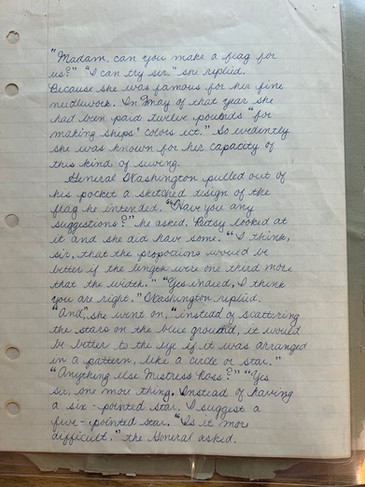Betsy Ross, USA Flag Creator, & My Teenage Hero - Part 2
- Terri Tomoff

- Oct 23
- 4 min read
This is Part 2 of yesterday's post, Part 1, on learning to quilt. Before diving into that, I'd like to share that I learned to crochet in 1976, the USA's bicentennial year. This was my mom's solution instead of my desire to learn to quilt and produce a quilted flag for my 8th-grade project in Social Studies. The bicentennial year of 1976 was a significant milestone in our country's history, celebrating its democracy. and a big deal. And while my mom taught me to crochet (not quilt, sigh) in that school year, I also had to write a report on someone from that time period. I selected my heroine, Betsy Ross. She was a well-known Philadelphia seamstress, using her advanced sewing skills to honor the thirteen colonies and her customer, General George Washington.
Using my best penmanship and research skills, I presented my report to my Social Studies Teacher in Period 6 and received an A+. My crocheted American Flag hung in the outer office showcase throughout the school year.
Following the copied photos of my original report, I also have the transcribed version, exactly as written in 1976:

BETSY ROSS
Betsy Ross was born in Philadelphia in 1752, and the daughter of Samuel Grimson, a Quaker carpenter. She also helped build Independence Hall.
Betsy was believed to have attended to the Friends School and in 1773 she eloped with John Ross. Mr. Ross was an upholsterer who owned a shop on Arch Street and had been killed by an accidental explosion of gunpowder while on sentry duty with the Pennsylvania militia. After his death Betsy carried on the business.
Soon after that Mrs. Ross remarried to Captain Joseph Ashburn and they had two daughters. Mr. Ashburn was captured by the British and was killed. One day, not long after that resolution about the flag was passed by Congress, three gentlemen called at the Ross shop, one of them General George Washington in 1776. George Ross, a signer of the Declaration of Independence and an uncle of Betsy Ross’ first husband was on the Committee also. The General asked her immediately.
“Madam, can you make a flag for us?” “I can try sir,” she replied.
Because she was famous for her fine needlework. In May of that year she had been paid twelve pounds “for making ships’ colors ect.” So evidently she was known for her capacity of this kind of sewing.
General Washington pulled out of his pocket a sketched design of the flag he intended. “Have you any suggestions?” he asked. Betsy looked at it and she did have some. “I think, sir, that the proportions would be better if the length were one third more that the width.” “Yes indeed, I think you are right,” Washington replied. “And,” she went on, “instead of scattering the stars on the blue ground, it would be better to the eye if it was arranged in a pattern, like a circle or star.” “Anything else Mistress Ross?” “Yes sir, one more thing. Instead of having a six-pointed star, I suggest a five-pointed star.” “Is it more difficult,” the General asked.
“Oh, no, sir.” She picked up her scissors, folded a piece of paper and cut out a star with a few snips. “Excellent, thank you, Madam, for you good ideas, we shall count on you to make the flag.” General Washington resketched the flag and sent it to an artist in the city to color, and finally it arrived to Betsy Ross and the pattern. She went to work at once, and when the flag was finished it was sent down to the wharves and run up on a vessel lying in the Delaware River. Everyone agreed it was beautiful.
Later it was carried to the Hall of Congress, and from that moment on it became the American Flag!
Following that summer of 1777, the Star-Spangled Banner went into general use with our force on the sea or land. Betsy received a contract for making flags for the government and it continued in force long after the War of Independence was won.
In 1783 Betsy remarried again to John Claypool and this marriage produced five more daughters.
In her old age Betsy became blind, but refused to sit still. With her skillful hands, she taught one of her daughters Clarissa, the art of flagmaking. She also trained her little grandson, inspite of her blindness, making rag carpets.
Betsy Ross died at the age of 84 in 1836.
This story was never told public until the year 1870, when her grandson, William Canby, related it in a paper that he read before the Pennsylvania Historical Society. It is that he himself heard his grandmother’s story from her own lips, because he was eleven years old when she died.
The Betsy Ross Memorial Association was formed in 1898 in her honor, and by 1905 they converted her old home and shop on Arch Street, Philadelphia, into a permanent memorial known as The American Flag House, in order that this story may never be forgotten.
The End.
_______________________________________
The books and authors are the following:
Famous Women of America by William Oliver Stevens, pgs. 23–26
The World Book Encyclopedia, Volume 16 Q–R, pgs. 443–444
The New Book of Knowledge, Volume 16 Q–R, pg. 335
Terri Nolan
Social Studies 6°
1976 – Charles A. Mooney Jr. High School, Cleveland, Ohio
8th-grade project
The crochet flag was showcased in a secure display case near the offices.
bSoleille!
Terri




















Comments